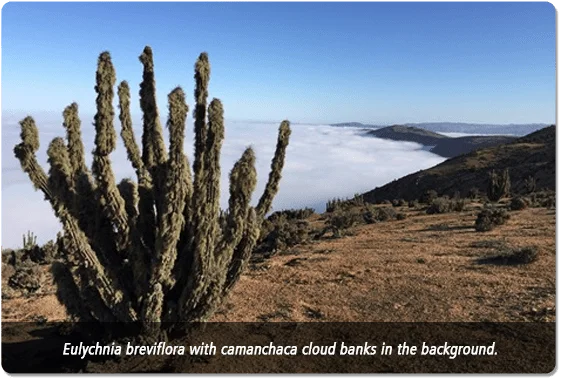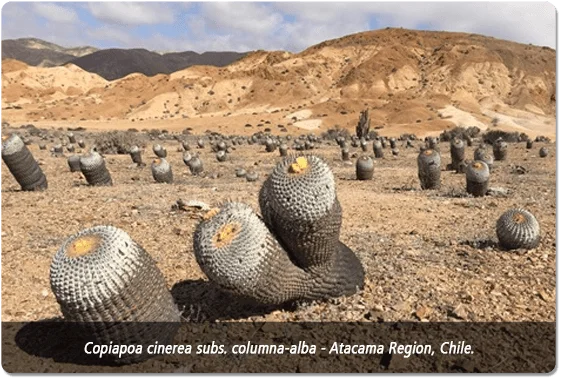Peru
Learn more about cacti Peru
CACTI OF PERU
Chile is home to over 140 species of cacti (Miesen, Eugenia de Porras, & Maldonado, 2015), most of which are located in Chiles north between 18° to 32°S (Moreira-Muñoz, 2011). Popular genre among cacti enthusiasts include Browningia, Copiapoa, Echinopsis, Eriosyce and Eulychnia.
ENVIRONMENT
Northern Chile comprises the driest non-polar desert in the world – the Atacama – recieving an average of 1-70mm of precipitation annually (Warren et al., 2016). Many species of cacti call the Atacama Desert home. Cacti have evolved to use water sparingly, but these are some extremely hyperarid conditions. Why is The Atacama Desert so dry? And how can cacti survive here?
The aridity of the Atacama Desert is the result of a two-sided rain shaddow caused by the Andes and the Chilean Coastal Cordillera.
Curiously, most Chilean cacti are streamlined directly along the top portion of the Coastal Cordillera. They are growing here because the camanchaca provides them with the moisture needed for them to survive in the Atacama Desert. Camanchaca are heavy fog banks that roll in from the Pacific Ocean and collect themselves against coastal cliffs (Warren, Aguilera & Baggett, 2016).
The particular cliffs and mountains in the above photo are located in Pan de Azúcar National Park and are a geomorphological characteristic of northern Chile. The cliffs rise from the subduction of the Nazca plate underneath the Southamerican Continental plate.


CACTI ADAPTATIONS
Cacti Adaptations
To survive, cacti needed to adapt to the extreme, hyperarid conditions of the Atacama desert. Thousands of years ago, cacti would have had leaves to facilitate photosynthisis, but the leaves have evolved into spines for two main reasons. The first is to minimise total plant surface area and therfore reduce the water lost during photosynthesis. The second is for defence from herbevores (Mauseth, Kiesling & Ostolaza, 2002).
The field of Copiapoa cinerea subs. columna-alba (pictured) is located in Pan de Azúcar National Park. It’s fascinating how this Copiapoa species all face north to the equator with such accuracy. This is because they are in the southern hemisphere, and also south of The Tropic of Capricorn – the suns southern most zenith, and are positioning their crown to recieve the most solar radiation possible for photosynthesis (Ehleringer, Mooney, Gulmon & Rundel, 1980).
The same phenomenon occurs with Ferocactus living in the Sonoran Desert, USA. The barrel cactus in the northern hemisphere generally face south equatorially for the same reasons (Ehleringer et al., 1980).
REFRENCES.
- Ehleringer, J., Mooney, H. A., Guymon, S. L., & Rundel, P. (1980). Orientation and its consequences for Copiapoa (Cactaceae) in the Atacama Desert. Oecologia, 46(1), 63-67. doi: 10.1007/BF00346967
- Mauseth, J. D., Kiesling, R., & Ostolaza, C. (2002). A cactus odyssey: journeys in the wilds of Bolivia, Peru, and Argentina. Timber Press (OR).
- Miesen, F., Eugenia de Porras, M., & Maldonado, A. (2015). Pollen morphology of Cactaceae in Northern Chile. Gayana Botanica, 72(2), 258-271.
- Moreira-Muñoz, A. (2011). Plant Geography of Chile. Springer Science & Business Media, United Kingdom. 368 pp.
- Warren, S. D., Aguilera, L. E., & Baggett, L. S. (2016). Directional orientation of reproductive tissue of Eulychnia breviflora (Cactaceae) in the hyperarid Atacama Desert. Revista Chilena de Historia Natural, 89(1), 10. doi: 10.1186/s40693-016-0060-z

